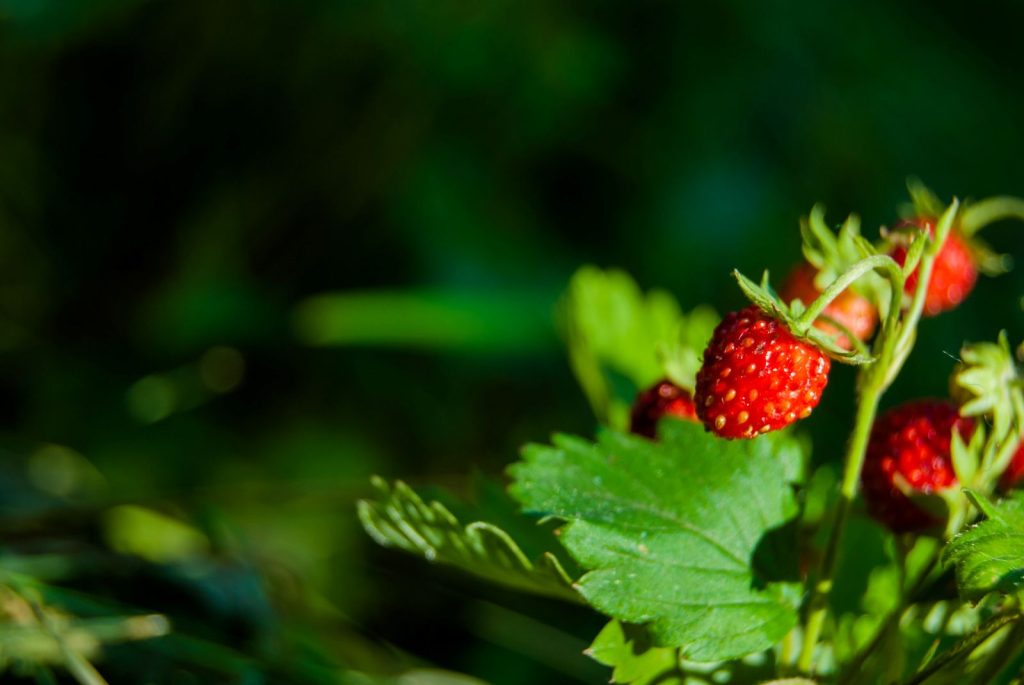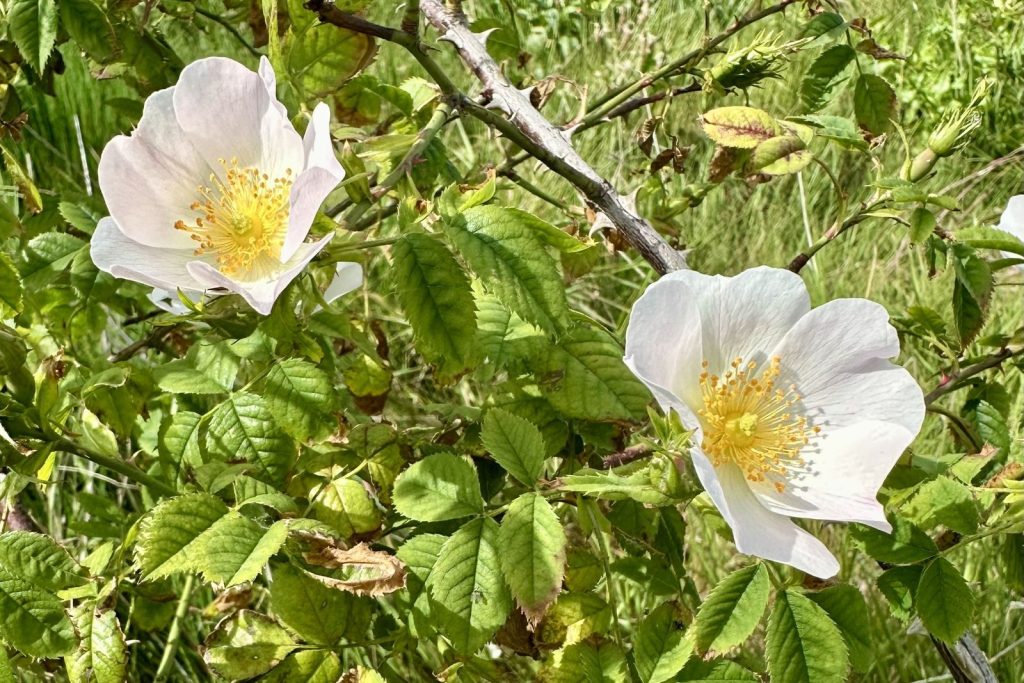Moon cycle:
- New Moon: 27th May 2025
- Full Moon: 11th June 2025
- New Moon: 25th June 2025
Strawberry Moon
The full Moon in June is often known as a ‘Strawberry Moon’ – a name used by the Algonquin and other native peoples of North America to signify the time of the year when wild strawberries could be picked and eaten. The Potawatomi people of the Great Plains of America are said to have called these berries the ‘heart berry’. Deep red and heart shaped, these wild fruits are much smaller than the cultivated varieties of strawberry we are familiar with. Storyteller and author Allison Galbraith adapts a traditional tale from North America for us, about the origin of wild strawberries.
Strawberries in the UK
Wild strawberries can be found ripening this month across the UK too, although they are less common in the far north of Scotland. These berries can provide a tasty snack, though as The Wildlife Trusts remind us, it is an offence to totally uproot a wild plant, and as with any foraged food, only eat it if you are completely sure you know what it is. The wild strawberry provides food for slugs, mice and birds and is valued by the caterpillars of the grizzled skipper butterfly, and the strawberry tortrix moth, while insects such as bumblebees, solitary bees and hoverflies drink from the flowers.
Yet, worryingly, wild strawberry plants are now classed as ‘near threatened’ because of the rapid loss of unimproved wildflower meadows. A staggering 97% of wildflower meadows have been lost since the 1930s, according to the Woodland Trust, due to the loss of traditional grazing, the switch from hay cutting to silage harvesting, and an increased use of fertilisers. We need a more harmonious approach!
Today, people are more familiar with eating cultivated strawberries. Homegrown varieties peak in the UK this month and strawberries are famously part of the traditional food served at the annual Wimbledon Tennis Tournament. However, weather changes due to climate change are having an impact on ripening dates: a warm, dry spring brought an early crop of the fruit this year whereas a wet spring last year delayed the growth period. So, while the name Strawberry Moon is arguably appropriate for us in the UK at the moment, it is a reminder that climate change is very much a threat to the timing of food availability we may take for granted.

Summer Solstice
There are so many events of note this month in the flora and fauna calendar, that there are several other contenders for this month’s Moon name. June is a month brimming with wildlife, and so it should be, as we head towards the longest day and the shortest night of the Summer Solstice in the northern hemisphere. Midsummer’s Day this year falls on June 21st (June 20–21), 10 days after the full Moon.
Honey Moon
An old English and medieval European name for this lunar month was the Honey Moon. It was a time for harvesting honey from hives and making mead, a traditional drink used at celebrations, especially weddings or hand-fasting, often a feature of the solstice celebrations.
Batty Moon
Did you know that bats make up more than a quarter of all mammal life in the UK? The increased warmth and lighter evenings means we are more likely to see bats as they become more active, catching thousands of insects a night. This is the month when bats are likely to give birth to and nurse their ‘pup’ – they usually only have one. The adults might feast on the plentiful insects but the pups feed on their mother’s milk. Look out for bats emerging at dusk from crevices, especially where they have access to roofs and old buildings.
Nightjar Moon
This month is a good opportunity to look out for and spot the elusive nightjar, a summer visiting bird from deep inside the continent of Africa. They are only here for a short while, returning to their winter grounds at the end of August, and are so well camouflaged that they can blend into the shades of bark on a tree. Nightjars have a distinctive ‘churring’ sound that you are most likely to hear on June evenings.
Rose Moon
However, another Moon name for this lunar month with European/Anglo-Saxon origins is the Rose Moon, signifying the widespread blooming of roses in the UK. The dog rose is a widespread, native, wild rose, easily spotted in hedgerows and woodland settings this month with its pink and white fragrant flowers, an important nectar source for insects. The rose fruit or rosehip is an important source of food for birds and some small mammals in the autumn. It is a humble, common plant but an important part of nature’s web.
There are many varieties of rose and many meanings associated with this iconic flower. Historically, the Tudor rose was adopted by Henry VII as England’s emblem of peace at the end of the War of the Roses, the civil wars between the royal house of Lancashire, who wore a red rose, and the royal house of York, who wore white. The Tudor rose combined both to symbolise peace.

Strawberry Rose Moon
The name ‘Rose Moon’ is a reminder of the beauty in the everyday, and also how the Tudor rose came to signify the end of a cycle of conflict and the beginning of a new, more unified era. The name ‘Strawberry Moon’ reminds us of nature’s treats and bounty. We are naming this lunar month the ‘Strawberry Rose Moon’ in recognition of the value of simple, natural food coupled with the importance of peace and harmony, especially between humans and the rest of the natural world.
Share your stories!
Do you like strawberries? Are there any grown near you? Perhaps in your garden or in a window box at school? Have you spotted any roses this month? What else is happening? What would you call this Moon?. Please tag us in your stories or pictures using the hashtag #EnvironmentalLunacy.
Related activity ideas
Do you have any commercial strawberry growing near you? Where is your nearest farm? Arrange a visit to see how the fruit is grown. Investigate your school grounds to see where you could plant strawberries. This might involve the creation of raised beds, or use of window boxes, hanging baskets and planters. Research the best varieties to grow.
Investigate a weather summary for spring and compare it with previous spring weather data where you live. Predict or explain how it might, or has, impacted on soft fruit growing near you.
What do wild strawberry plants look like? Using an app like Google Lens, walk around the school and local area, mapping where they occur. Create some annotated sketches of where they grow and the kind of habitat they thrive in. Note other insects and flowers seen nearby.
It is said that the illustrator William Morris created this famous textile design after watching thrushes steal strawberries from his garden. If you have access to a patch of strawberries watch what comes along to eat them or leave a camera trap. Use strawberries on a bird table and watch to see which birds like them best. Create your own repeating patterns inspired by strawberries.
This time of year can be quite warm. Plan a trip to your local shop where you can buy seasonal, locally grown fruit like strawberries to make a slushy. Research recipes and create your own.
Can you spot dog roses in the hedgerows and verges? Map where they are and note the date of the first blooms spotted. Keep the dates in a diary to be added to in subsequent years.
The rose chafer is a bright, shiny green beetle with little white streaks on its wing cases. It loves to feed on flowers, especially dog roses. Watch, photograph, or sketch the insects that visit roses on warm June days where you are and you may be lucky enough to catch a glimpse of this widespread, but uncommon creature.
If you don’t grow roses already in your school garden, research a site, then design and plant a rose garden. Select colours and scents that will catch the eye and delight the senses as midsummer draws near.
Resources and useful websites
- Bats – Bat Conservation Trust
- Dog Rose – The Woodland Trust
- Nightjar – RSBP
- Will 2025 be a sweet year for strawberry growers and consumers? – BBC
- Wild Strawberry – Wildlife Trusts
- Wildlife in June – RSPB
Authored by Lola O’Brien and Paula Owens. Lola is a school student in Year 10. She co-wrote and researched this Blog as part of her school work experience. Paula Owens is an independent education consultant, and a Trustee of NAEE.
